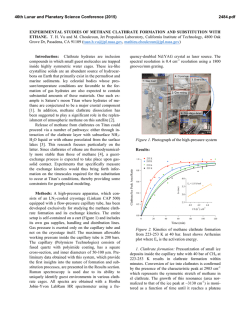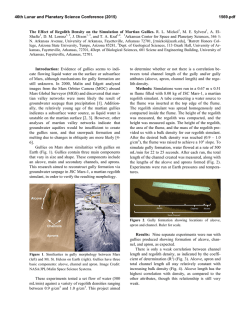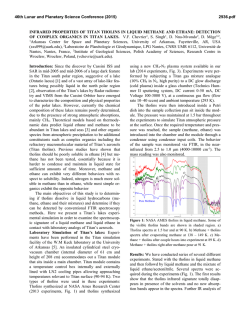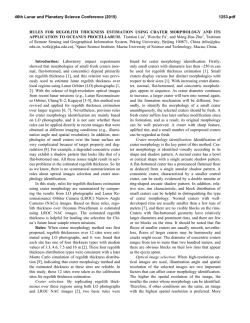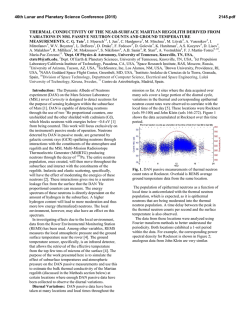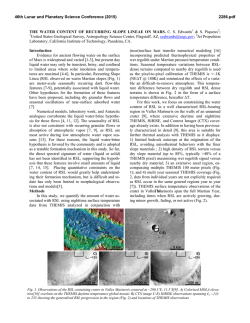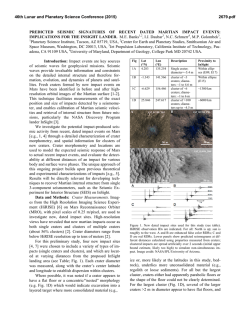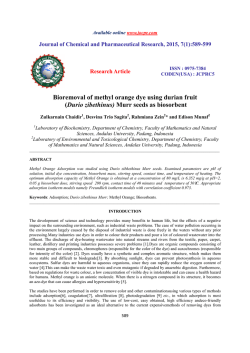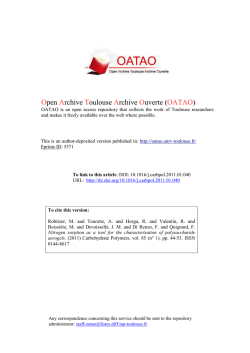
Hypotheses for a Near-Surface Reservoir of Methane and Its
46th Lunar and Planetary Science Conference (2015) 2279.pdf Hypotheses for a Near-Surface Reservoir of Methane and Its Release on Mars. R. Hu1,2,3, P. Gao2, C. E. Miller1 and Y. L. Yung1,2, 1Jet Propulsion Laboratory, California Institute of Technology, Pasadena, CA 91109, 2Division of Geological and Planetary Sciences, California Institute of Technology, Pasadena, CA 91125, 3Hubble Fellow ([email protected]). Introduction: The Tunable Laser Spectrometer (TLS) onboard the Curiosity rover has recently detected methane on Mars[1]. This result provides a groundtruth measurement that resolves the controversy over methane on Mars indicated by previous efforts in remote sensing[2-5]. The discovery of methane reorients our understanding of the Martian environment and its potential for life. The current theoretical framework of Mars geology and atmosphere does not entail any active source of CH4, and it predicts a methane lifetime of ~ 300 years in the Martian atmosphere, far shorter than the planet’s age[6-9]. Hence, methane’s atmospheric existence requires a continually replenishing source, potentially subverting assumptions of a geologically and biologically dead Mars. In addition to detecting a background atmospheric mixing ratio of methane of 0.69±0.25 ppbv at the 95% confidence level, the TLS also detects elevated levels of methane of 7.2±2.1 (95% confidence level) in 5 samples spanning a few tens of Sols[1]. These methane “spikes” suggest episodic sources of methane that are yet to be discovered. Here we outline three hypotheses in an attempt to explain the apparent variability of the atmospheric methane abundance at Gale Crater. The first hypothesis is that the regolith in Gale Crater adsorbs ~7 ppbv equivalent of methane and releases this methane to the atmosphere when the relative humidity in the regolith is high enough for perchlorate salts to deliquesce during the northern summer. The second hypothesis is similar to the first one in that the regolith temporarily stores methane, but differs from the first one in that the Curiosity rover itself disrupts the regolith during its traverse and causes it to desorb due to friction between regolith grains. The third hypothesis draws from an analogy to terrestrial arctic tundra where episodic releases of methane have recently been observed and interpreted as a result of freezing and thawing of the permafrost[10,11]. Hypothesis I: The observations of elevated methane levels occurred when the Rover Environmental Monitoring Station (REMS) onboard Curiosity measured surface relative humidities greater than 60%, except for a single measurement on Sol 306[1]. The methane measurement on Sol 306 is 5.78±4.54 ppbv at the 95% confidence level, so its statistical significance is only marginal. It is now known that the Martian regolith contains 0.5% perchlorate salts by weight[12-14]. These salts are important because they may deliquesce (i.e., become liquid by absorbing moisture from the air) under Martian conditions due to their low eutectic temperature and low deliquescence relative humidity (DRH)[15,16]. Recent laboratory measurements have determined that the DRH of calcium perchlorate is ~50% at 200 K, and that the deliquescent salt does not lose moisture until the relative humidity drops to ~15%[15]. By comparing the eutectic temperature and the DRH to the surface temperature and the surface relative humidity measured by REMS, we postulate that perchlorate salts in the subsurface of Gale Crater might deliquesce in the northern summer, during which the elevated methane levels were measured. For perchlorate deliquescence to explain the methane spikes, two conditions must be met: First, the first 1 – 3 meter of regolith must be able to adsorb ~7 ppbv equivalent of methane when the soil particles are dry; second, when deliquescence occurs, the wet salt can coat the soil particles and deactivate most active sites, releasing methane to the atmosphere. Using the REMS surface temperature data archived at the Planetary Data System, as well as the thermal inertia of the region of Gale Crater[17], we calculate the temperature profile of the subsurface regolith as a function of time. This allows quantitative evaluation of the two aforementioned conditions. For the first condition, we find that the energy of adsorption must be on the order of 7 kcal/mol. We estimate the capacity of methane adsorption by assuming Langmuir isotherm equilibrium, a number of active sites available for methane per unit surface area of 5.2✕1018 m-2[18], an active area per unit mass of regolith of 100 m2 g-1, and a regolith density of 1.6 g cm-3[19]. In our formulation, the energy of adsorption is the only free parameter. The energy we find is 60% higher than laboratory measurements[18], posing a major challenge to this hypothesis. One possibility is that the energy of adsorption is highly sensitive to the composition and the texture of the soil, and experiments using terrestrial samples may not represent the Martian surface. This suggestion is corroborated by a recent experiment that showed that quartz grains were able to adsorb a much larger number of methane molecules per unit surface area, which implies greater adsorption energies[20]. 46th Lunar and Planetary Science Conference (2015) For the second condition, we find that most of the perchlorate salts in the top 3 m of regolith is deliquescent during nighttime in the northern summer (Figure 1). This seasonal behavior of the soil is consistent with the TLS’s measurements of elevated methane levels on Sol 466, 474, 504, and 526, but not consistent with the measurement on Sol 306. A recent laboratory experiment suggests that bulk deliquescence of perchlorates is not rapid enough to occur in a night if water vapor is the only source of water[21], posing another challenge to the hypothesis. We also note that the salts may dry during the daytime due to strong diurnal temperature variations, and yet one of the measurements of elevated methane levels was taken during the daytime (Sol 526). This may not challenge the hypothesis, since it takes more than a day for the atmospheric methane to diffuse into the regolith and be re-adsorbed. Depth of Deliquescent Soil [cm] 300 250 200 150 100 50 0 0 50 100 150 200 L S [degree] 250 300 350 Figure 1: Depth of deliquescent soil in the top 300 cm of regolith in Gale Crater, as a function of the solar longitude (LS). The REMS ground temperature measurements are used to calculate the subsurface temperature, and the REMS relative humidity measurements are used to determine the onset of deliquescence and efflorescence. We assume calcium perchlorate is uniformly mixed in the soil. Hypothesis II: This scenario is similar to the first one, except that the adsorbed methane is released mechanically by the Curiosity rover itself. The tracks left behind by Curiosity indicate disruption, grinding, and overturning of the top few centimeters of regolith. This may be enough to remove some of the methane adsorbed on the regolith grains due to the friction between them[22]. Alternatively, the compression of the soil beneath the rover due to its weight may also lead to friction between the grains and methane desorption. The first scenario would require a few ppb equivalent of methane to be adsorbed by a few centimeters of soil, implying a much greater energy of adsorption than 7 kcal/mol. This would also imply that the daytime measurements should always find elevated methane levels, consistent with the TLS results so far. However, the very large adsorption energy required is not supported by laboratory experiments[18]. The second scenario would depend on the porosity of the regolith, as well as the detailed material properties. 2279.pdf Hypothesis III: Another possibility is that the elevated methane measured by TLS represents unknown sources of “new” methane into the system. The sources of methane may include subsurface gas-water-rock chemistry and microbial methanogenesis[8,23], with the difference being that biological methanogenesis is much faster than gas-water-rock reactions[24]. A Martian analog to surface-atmosphere methane fluxes from the terrestrial arctic tundra is of particular interest. The arctic tundra is one of the major sources of methane to for Earth’s atmosphere. Concentrated bursts of methane have been observed at tundra sites in late fall as the seasonally thawed active layer refreezes, forcing sub-surface methane into the atmosphere[10]. Similar bursts have been observed during the spring freeze-thaw transition when subsurface methane trapped by the frozen surface escapes[11]. The fall and spring bursts are transitory (occurring only for a <10 day window immediately surrounding the freeze-thaw transition) and episodic (they do not occur every season), and the magnitude of the methane emissions is highly variable. This methane release mechanism requires production of methane, near the surface, over a timescale of about one year. On Earth, this is achieved by biological methanogenesis. Given that the TLS’s methane spikes are mostly measured during the late southern fall, one may postulate that processes similar to the terrestrial tundra also operate on Mars. References: [1] Webster C. R. et al. (2015) Science, in press. [2] Formisano V. et al. (2004) Science, 306, 1758. [3] Krasnopolsky V. A. et al. (2004) Icarus, 172, 537. [4] Mumma M. J. et al. (2009) Science, 323, 1041. [5] Zahnle K. et al. (2011) Icarus, 212, 493. [6] Summers M. E. et al. (2002) GRL, 29, 2171. [7] Nair H. et al. (2005) Icarus, 175, 32. [8] Atreya S. K. et al. (2007) P&SS, 55, 358. [9] Lefèvre F. and Forget F. (2009) Nature, 460, 720. [10] Mastepanov M. et al. (2008) Nature, 456, 628. [11] Song C. et al. (2012) Environ. Res. Lett., 7, 034009. [12] Hecht M. H. et al. (2009) Science, 325, 64. [13] Leshin L. A. et al. (2013) Science, 341, 6153. [14] Ming D. W. et al. (2014) Science, 343, 6169. [15] Nuding D. L. et al. (2014) Icarus, 243, 420. [16] Rummel J. D. et al. (2014) Astrobiology, 14, 887. [17] Putzig N. and Mellon M. T. (2007) Icarus, 191, 68. [18] Gough R. V. et al. (2010) Icarus, 207, 165. [19] Mellon M. T. and Jakosky B. M. (1993) JGR, 98, 3345. [20] Jensen S. J. K. et al. (2014) Icarus, 236, 24. [21] Fischer E. et al. (2014) GRL, 41, 4456. [22] Borodich F. W. and Keer L. M. (2005) Thin Solid Films, 476, 108. [23] Schulze-Makuch D. et al. (2008), International Journal of Astrobiology, 7, 117. [24] Yung Y. L. et al. (2010), Journal of Cosmology, 5, 1121.
© Copyright 2026
